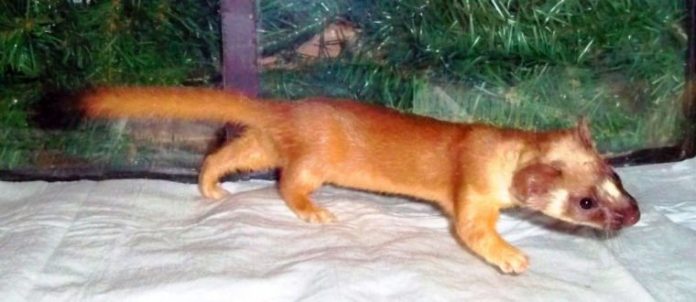Since 2005, I’ve been writing monthly tales about the animals that have been cared for at the Wildlife Education and Rehabilitation Center in Morgan Hill. Eagles, owls, hawks, falcons, song and water birds, opossums, bobcats, rabbits, turkey vultures and snakes have been featured. But it took all these years to have a repeat of the very first “Animal of the Month” – a long-tailed weasel. The original was a healthy but hungry six-inch long orphan found abandoned in San Juan Bautista. WERC’s latest arrival had a much more inauspicious circumstance: it was caught by a cat in a Gilroy resident’s backyard and suffered puncture wounds on his head. It was feared the tussle might have caused grave trauma to the weasel’s spinal cord, possibly paralyzing the back legs.
The rescuer immediately brought the weasel to Dr. Suzanne Colbert who gave the 10-inch-long critter a thorough examination under anesthesia (a necessary precaution because of the weasel’s needle-sharp teeth), and treated him with antibiotics and flea medication. For the next three days at WERC, the weasel appeared to be recovering well, and he was a curious, active little animal with a hearty appetite. But soon, he began developing a large, painful lump behind his left ear and was holding his head at an angle.
Colbert lanced the abscess and staff at WERC are providing twice daily medication and wound care to ensure the weasel heals well and quickly. The weasel is one slippery and spry animal that requires careful handling with a firm but gentle grasp while wearing leather gloves – and that’s after finally getting a hold of him. An extra “benefit” noticed by staff giving him treatment is the distinctive aroma of musk that the weasel emits from his scent glands when he’s frightened or agitated.
Once the weasel is out of critical care, he will be transferred to an outdoor enclosure that will be specially modified to mimic the idiosyncrasies of the weasel’s native habitat: Tunnels to run through, dirt mounds to dig into and rock piles to clamber over. He will be fed a natural diet including small rodents and quail. When he is about 12 weeks old and reaches his adult length of 14 to 16 inches, he will be released near his native habitat, as required by state laws for mammals.
The long-tailed weasel (Mustela frenata), can be found in most of the United States, Southern Canada, Mexico, Central and South America. The carnivorous animal is a fearless, aggressive, a voracious hunter and a valuable natural asset in controlling rodents. Using scent and sound to track its prey, the solitary weasel forages day and night for mice, rats, squirrels, chipmunks, shrews, moles, small birds, reptiles and rabbits. Small in-ground, tree-dwelling and aquatic animals are not safe – the weasel can shimmy down burrows, climb trees and is an excellent swimmer. But it’s a prey-eat-prey world in the wilderness: Hawks, owls, cats, foxes and snakes pursue the weasel. Humans hunt it, too, although its fur isn’t considered particularly valuable.
The long-tailed weasel is a habitat generalist, living in a wide variety of environments including woodlands, brushlands, grasslands, open areas, farmland and suburban backyards – almost anywhere there is an abundance of prey, ample cover and a good water source. It lives in the abandoned burrows of mammals such as chipmunks, in rotting logs or under tree roots or rocks.
While everyone at WERC has fallen in love with this “cute” critter, we’re all looking forward to the day we see him scampering off to freedom in the wild. Though weasels appear similar to domesticated ferrets, the weasels DO NOT make good pets (besides being illegal in California to keep one). As with all wildlife, unless they are in imminent danger or obviously injured, leave them alone and contact your local wildlife rehabilitation facility for advice.












